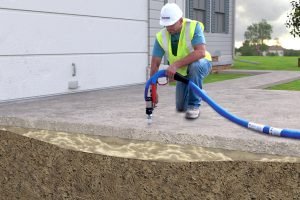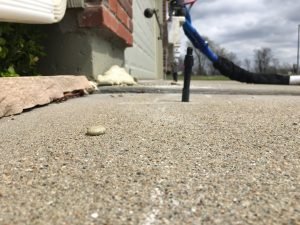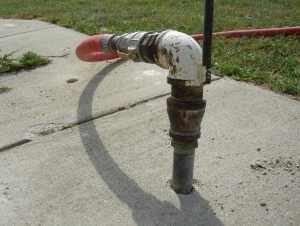To repair a sunken and misaligned concrete driveway for a fraction of the cost of a full replacement, mudjacking (or slab jacking) is done in an effort to raise and pitch the slabs to the desired height. Almost any size concrete slab can be treated in this manner. However, most attractive is the fact that results can be achieved in a fraction of the time and costs of replacing the slabs.
What Exactly is MudJacking
 Mudjacking is the process of taking existing concrete that has settled and become uneven with other slabs around it and raising it to an even level by pumping a slurry of mud underneath the slabs.
Mudjacking is the process of taking existing concrete that has settled and become uneven with other slabs around it and raising it to an even level by pumping a slurry of mud underneath the slabs.
This is done by creating holes in the slab and inserting a hose that proceeds to pump a mixture underneath until it is raised to a suitable level.
Originally, mudjacking used a mixture of topsoil and cement. However, over time other materials began to replace topsoil due to its organic properties that eventually break down.
Instead, materials like pond sand, river sand, lime screenings, and fly ash is mixed with cement and water.
Mud jacking is ideal for smaller jobs such as raising porches, steps, and other small concrete surfaces.
Does mud jacking really work?
Yes. Mud jacking is a cost-effective solution and although may not be a permanent solution in some instances, it still comes with a host of benefits.
Where can mud jacking be applied?
Leveling concrete via mud jacking can be applied the following surfaces:
- basement floors
- garage floors
- pool decks
- porches
- stairways
- sidewalks
- walkways
What Are The Benefits of Mud Jacking?
Mud jacking can be performed in almost any weather condition and time of year.
 This quick process can be completed in as little as a day, while smaller jobs might be completed in a few hours. This saves a lot of time and money compared to the old “rip-and-replace” approach whereby the concrete slabs are replaced.
This quick process can be completed in as little as a day, while smaller jobs might be completed in a few hours. This saves a lot of time and money compared to the old “rip-and-replace” approach whereby the concrete slabs are replaced.
This type of work is not messy. Once the job has been completed, the slurry can take anywhere from 24-48 hours to dry.
Compared to concrete which takes up to 28 days, its obvious to see why mudjacking is the first option for many homeowners.
In addition, mudjacking causes no damage to the surrounding areas such as the lawn or garden and there is not much cleanup required after completion.
The downside to mudjacking
Unfortunately, mudjacking is not a DIY suitable process. It doesn’t fix cracks and is only useful to lift sunken slabs. Should you have any cracks present, it is a separate issue that may have to be addressed. If the slabs are completely cracked and crumbling, mudjacking is not an option.
Mudjacking also does not address the issue that caused sinking in the first place. I many cases, the cause of the problem may have to be addressed first.
Equally, if the slurry material is too rough in texture, it will not fill the void underneath completely, leaving room for water to penetrate and wash away the slurry over time.
Another major downside to this type of project is that it does not come with any warranties. After the work has been completed, some of the concrete slabs may begin to slope again. If your soil is unstable, mudjacking is definitely not an option.
How Much Does Mudjacking Cost?
Depending on your regional location’s pricing trends, the cost of mudjacking a sidewalk or driveway will differ.
 We highly recommend you get in touch with local experts to discuss your options and request a free estimate.
We highly recommend you get in touch with local experts to discuss your options and request a free estimate.
Based on national averages, homeowners should budget in the region of about $950 for roughly 100 sq. ft. surface area.
On the lower end of the spectrum, this could be as affordable as $485.
On the higher end of the spectrum, you can expect to pay around $1,325.
However, most consumers report a cost of $5-$8 per sq. ft. , which translates to anywhere between $500–$800 for an average-sized residential project.
Ask For a Free Estimate from Local Experts
Are you interested in mudjacking repair? Why not get in touch with a professional near you to get a more accurate idea of how much this type of repair work is going to cost you.